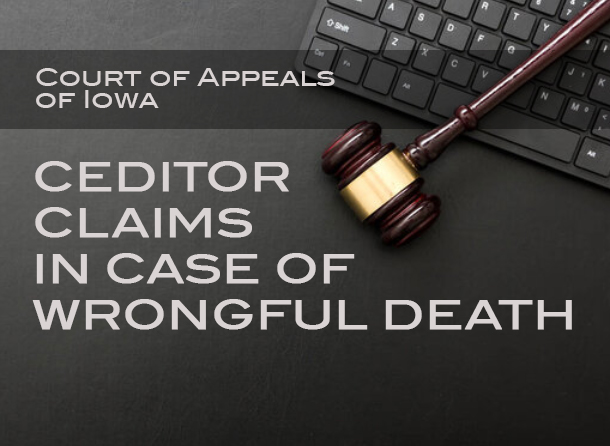On June 15, 2022, the Court of Appeals of Iowa issued an opinion in the matter of the Estate of Kevin L. Barz, Brad Staley and Susan Staley, Appellants (No. 21-0563).
 The case involves Kevin Barz and his spouse who both died in a motor vehicle accident. The Barz’s were survived by three children who were the co-executors of the estate. The co-executors filed a wrongful death action against the tortfeasor and his insurance company. A settlement was reached with the tortfeasor for $622,264.15. The settlement provided that it “was paid solely as compensation for the individual loss of consortium”. The co-executor’s sought approval of the settlement. Brad and Susan Staley filed a resistance to the application. The Staley’s, who were creditors of the decedent, claimed that it was “not in the best interest of the estate to permit the co-executors to compromise the estates wrongful death claim in such a way that almost all of the proceeds are diverted from the estate and therefore, cannot be used to pay creditors”. The Staley’s also filed a motion for removal of the co-executors and for the appointment of a special substitute co-executor. The co-executors also reached a settlement with the insurance company for the policy limits of $250,000.00 and amended their application to seek approval of such settlement. The co-executors asked for the “apportionment of the portion of the proceeds of both settlements compensating (them) for their individual loss of consortium claims”.
The case involves Kevin Barz and his spouse who both died in a motor vehicle accident. The Barz’s were survived by three children who were the co-executors of the estate. The co-executors filed a wrongful death action against the tortfeasor and his insurance company. A settlement was reached with the tortfeasor for $622,264.15. The settlement provided that it “was paid solely as compensation for the individual loss of consortium”. The co-executor’s sought approval of the settlement. Brad and Susan Staley filed a resistance to the application. The Staley’s, who were creditors of the decedent, claimed that it was “not in the best interest of the estate to permit the co-executors to compromise the estates wrongful death claim in such a way that almost all of the proceeds are diverted from the estate and therefore, cannot be used to pay creditors”. The Staley’s also filed a motion for removal of the co-executors and for the appointment of a special substitute co-executor. The co-executors also reached a settlement with the insurance company for the policy limits of $250,000.00 and amended their application to seek approval of such settlement. The co-executors asked for the “apportionment of the portion of the proceeds of both settlements compensating (them) for their individual loss of consortium claims”.
The District Court citing Iowa Code Section 633.336 (2019), found that the proceeds of the wrongful death settlement were not subject to the claims of creditors. The Court went on to approve both settlements and ordered them “apportioned and distributed equally to each of the Applicants” subject to the designated exceptions for payment of medical subrogation liens and for payment of medical bills for Kevin Barz and stated that none of the settlement amounts were available to pay creditors.
On appeal the Staley’s alleged that some of the damages recovered are estate assets and should be turned over to the estate and administered consistent with Iowa law. The Court of Appeals went on to examine the legislature history to decide if any ambiguity exists in the statute. The Court cited England’s enactment of Lord Campbell’s Act in 1846 which created a wrongful death action for the benefit of the wife, husband, parent, and child of the decedent, and which provided that the damages would be apportioned among the group of them. The Court went on to note that the State of Iowa enacted a wrongful death statute shortly thereafter. Such statue disallowed creditor claims on wrongful-death damages where the decedent was survived by immediate family members. The court noted that the provision remained substantially unchanged for over 100 years.
The Staley’s also alleged that an error occurred when the District Court failed to apportion damages without an evidentiary hearing. Furthermore, the Staley’s alleged that the District Court erred when they found the co-executors did not have a conflict of interest. The Court of Appeals found that the District Court did not err in concluding that the co-executors lacked standing to raise said issues. The Court of Appeals affirmed the decision of the District Court.